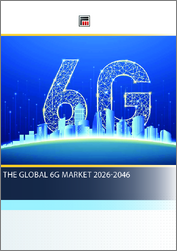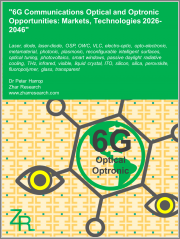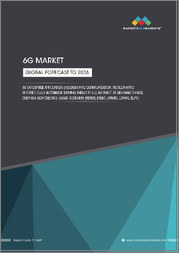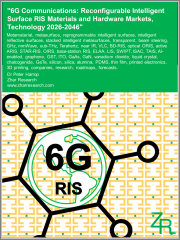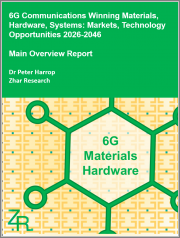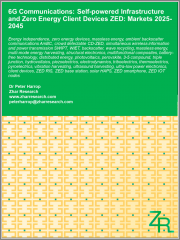
|
시장보고서
상품코드
1533184
6G 통신 : 자가 발전 인프라 및 클라이언트 ZED(제로 에너지 디바이스) 시장(2025-2045년)6G Communications: Self-powered Infrastructure and Zero Energy Client Devices ZED: Markets 2025-2045 |
||||||
6G 통신의 성공에는 필요한 거의 모든 곳에서 우수한 성능으로 작동하는 것이 필수적입니다.
자가 발전으로 거의 어디에서나 작동
기지국, 고객 구내 설비, 그리고 새롭게 필수불가결해진 RIS 등, 미약한 고주파를 목적지까지 전달하기 위한 공사는 불필요해져, 유선 접속이나 충전기를 필요로 하는 클라이언트 디바이스도 없어질 것입니다. 한편, 태양광만으로 성층권을 수년간 비행하는 태양 드론 「하늘의 탑」과 같은 자기 발전형의 인프라가 등장할 것입니다. 효율 40%의 태양광 발전 및 기타 수확 기술로 자체 발전하는 6G 클라이언트 장치를 생각해 봅시다. 필요할 때 신호로 구동하는 전지 불필요한 클라이언트 디바이스를 추가해, 설치한 후에는 잊어버리는 기쁨을 즐깁니다.

본 보고서에서는 6G 통신의 자가발전 인프라 및 클라이언트 ZED(제로에너지 디바이스) 시장을 조사했으며, 6G ZED 인프라와 클라이언트 디바이스의 실현 기술 개요, 새로운 기회, 기술 로드맵, 시장 규모 추이 및 예측, 주요 기업의 대처 등을 정리했습니다.
이 보고서는 106개 이상의 기업을 다루고 약 1,000 개의 최신 연구 논문 및 기업 활동을 추출하고, 107개의 인포 그램, 표 및 그래프, 10개의 SWOT 평가, 14개의 예측 라인(2025-2045년)을 정리했습니다.
목차
제1장 주요 요약 및 총론
- 목적 및 범위
- 조사 방법
- 20의 주요 결론
- ZED의 컨텍스트 : 중복 및 인접 기술 및 장수명의 에너지 독립형 디바이스의 예
- 주요 6G 인프라 및 클라이언트 디바이스가 제로 에너지, 전지 프리, 장수명화를 실현
- 전지 불필요한 6G ZED를 실현하는 주된 기술
- 조합 가능한 8가지 옵션
- 6G 통신에서 ZED의 중요성
- 6G ZED 및 실현 기술의 로드맵
- 시장 예측
제2장 서문
- 개요
- 6G의 기초
- 6G 1단계와 2단계에서 ZED의 필요 및 기회
- 6G ZED 관련 기타 자료
제3장 6G ZED 인프라 및 클라이언트 디바이스 실현 기술 : 메타물질, IRS, RIS, 구조 전자
- 제로 및 저전력 인텔리전트 서피스와 솔라 강화를 제공함으로써 6G ZED를 가능하게 하는 메타물질 및 메타서피스
- 메타물질, IRS, RIS의 개요
- 예 : 5G 및 6G용 메타물질 IRS ZED 창
- 메타물질 툴킷의 주요 예, 6가지 포맷, 6G ZED의 관련성
- 메타 원자 재료, 디자인, 패턴 형성 옵션
- 6G 이용을 위한 상업적, 운용적, 이론적, 구조적 옵션의 진화
- 6G RIS 서브 THz, THz, 광학 버전에 적합한 메타물질 제조 기술
- 재구성 가능한 지능형 서피스 및 기타 목적을 위한 메타서피스
- 6G IRS 및 RIS에서 사용되는 주요 재료
- 6G RIS의 구성 및 동작
- 6G RIS용 8개의 튜닝 디바이스 패밀리 및 그 재료 요건
- 디스크리트 보드, 적층 필름으로부터 풀 스마트 재료의 통합, 구조 일렉트로닉스까지의 트렌드
- 6G ZED에 도움이 되는 메타서피스 에너지 회수 강화
- 메타물질 기반 6G ZED 기술의 3 가지 SWOT 평가
- 메타물질 및 메타 서페이스 전반의 SWOT 평가
- ZED 버전을 포함한 미래의 6G RIS 설계를 이끄는 SWOT 평가
- 6G 통신 IRS 및 RIS 기회의 SWOT 평가
제4장 6G ZED 실현 기술 : SWIPT, AmbBC, CD-ZED
- 개요 : 6G ZED를 실현하는 후방 확산 및 SWIPT
- 하이브리드 빔포밍 베이스의 SWIPT
- AmBC 및 CD-ZED
제5장 6G ZED 실현 기술 : 6G 인프라 및 클라이언트 디바이스의 에너지 회수
- 개요 : 변화하는 요구와 13의 기술
- ZED에서 검토되고 있는 13유형의 에너지 회수 기술
- 전자기 방사의 회수 : 태양광 발전, 주위 RF
- 기계적 방출 회수 : 초저주파음, 음향, 진동, 전기역학, 압전, 마찰전기, 기타 기술
- 열전, 초전, 수력, 바이오연료전지 등의 옵션
- 개요
- 열전
- 초전형
- 열수력 발전
- 바이오연료전지
- 기타 옵션
제6장 6G ZED의 실현성을 높이는 초저전력 일렉트로닉스 및 전기
- 개요
- 시스템 레벨의 에너지 절약
- 컴포넌트 레벨의 에너지 절약 : 초저소비 전력 집적 회로, 저소비 전력 디스플레이 등
제7장 전지 불필요 6G ZED를 위한 전지의 배제 및 슈퍼커패시터
- 개요
- 선택 범위 : 커패시터에서 슈퍼커패시터, 배터리까지
- 리튬 이온 커패시터의 특징
- 슈퍼커패시터 및 그 파생 제품의 실제 및 잠재적인 용도
- ZED용 전지 불필요 스토리지 기술의 SWOT 평가
- 슈퍼커패시터와 그 변형에 의해 실현되는 ZED의 예
- 질량 제로의 에너지 슈퍼커패시터 구조 일렉트로닉스
- 연구 파이프라인 : 슈퍼커패시터
- 연구 파이프라인 : 하이브리드 접근
- 연구 파이프라인 : 슈도 커패시터
Essential to success of 6G Communications will be it working with superior performance almost anywhere you need it. The new 397-page, commercially-oriented report, "6G Communications: Self-powered Infrastructure and Zero Energy Client Devices ZED: Markets 2025-2045" reveals huge opportunities in a relatively neglected yet essential key enabling technology.
Self-powered, working almost everywhere
Gone will be earthworks to base stations, customer premises equipment and those newly-essential reconfigurable intelligent surfaces RIS everywhere to get the feeble higher frequency emissions to destination. Gone will be client devices hard-wired or in need of chargers. Welcome self-powered infrastructure such as the solar drone "tower in the sky" aloft for years in the stratosphere on sunshine alone. Think self-powered 6G client devices with 40% efficient photovoltaics and other harvesting. Add battery-free client devices powered by signal when needed and delights of fit-and-forget.
Uniquely up-to-date and insightful
This PhD level analysis has 7 Chapters, 10 SWOT appraisals, 14 Forecast lines 2025-2045, over 106 companies mentioned, 107 infograms, tables, graphs distilling about 1000 latest research papers and company initiatives.
It assists those entering the value chain of 6G Zero Energy Devices ZED. Useful to investors, materials and device suppliers and system integrators seeking to pull ahead, it provides insightful PhD level analysis of the latest research, heavily biassed towards 2024 announcements. It is constantly updated so you only get the latest. Absorb new industrial initiatives, research advances and expert opinions.
The forecasts presume that 6G will succeed but the analysis is balanced, detailing pros and cons. Topics covered extend well beyond electronic and electrical equipment and devices that make all their electricity with on-board ambient energy harvesting, increasingly multi-mode. Understand simultaneous wireless information and power transfer SWIPT enabling devices to power up when needed from the signal beam and even research on harvesting electricity from the signal. See electronic devices that need no power such as 6G passive metamaterial reflect-array surfaces you can supply.
The report analyses enabling technologies arriving such as ultra-low power electronics and metasurfaces needing only a whisper of electricity, transparent and battery-free technology all leading to the new world of very-long-life, fit-and-forget 6G devices and infrastructure often vanishing into the fabric of society.
Questions answered include:
- How can I create a $1 billion 6G ZED business?
- Potential competitors, partners or acquisitions?
- Market and technology roadmap for 2025-2045?
- Technology readiness and potential improvement?
- Appraisal of needs and appropriate technology options?
- Market drivers and forecasts of background parameters?
- Market forecasts by technology and application 2025-2044?
- Deep analysis of research pipeline including 2024 with implications?
- Explanation of trend to "massless energy", and other structural electronics?
- Battery-free, ultra-low power electronics, non-toxic, non-flammable options emerging?
The Executive Summary and Conclusions (41 slides) compresses it all into visuals, roadmaps and forecasts. The Introduction (54 slides) gives 6G justification, basics, disruptive aspects, challenges and arguments against. However, mostly it outlines ZED needs and opportunities in 6G Phase 1 and 2, examples including wireless powered IoE for 6G, zero-energy device networks with wireless-powered RIS and ZED Machine Type Communications MTC. Learn zero-energy air interface for advanced 5G and for 6G and the first real-time backscatter communication demonstrated for 6G. See further reading from 2024 and 2023 research.
Chapter 3. "6G ZED infrastructure and client device enabling technology: metamaterials, IRS, RIS, structural electronics" uses 34 pages including six SWOT appraisals to cover these basics. They include passive metamaterial reflect-arrays that need no power and semi-passive RIS needing almost no power - easily made ZED.
One route to energy independence is greatly advancing the backscatter principle of the world's most numerous electronic devices - battery-free RFID and anti-theft tags. Chapter 4. "6G ZED enabling technology: Simultaneous wireless and information transfer SWIPT, Ambient backscatter communications technology AmBC, crowd-detectable zero energy devices CD-ZED" (24 pages) addresses this and allied matters.
The largest chapter concerns the most prevalent ZED technology likely for 6G infrastructure and client devices which is reinvented on-board energy harvesting, far more powerful than we know today. The 142-page Chapter 5. "6G ZED enabling technology: energy harvesting for 6G infrastructure and client devices" makes sense of the flood of research advances particularly in 2024 and latest trials such as HAPS drones aloft on thin-film triple junction photovoltaics alone. Expect up to four energy harvesting technologies in a given device, chosen from 13 candidate harvesting families appraised, together very lightweight, low volume, low cost and producing ten to one hundred times the power. Appropriately, 49 pages are on next photovoltaics - research, demonstrations, company trends. With one micron-thick and even spray-on photovoltaics in prospect, the doubling of efficiency to around 40% will be dwarfed by PV area increasing at least ten times as it appears on all surface shapes and locations. There is good coverage of solar drones including two very significant demonstrations of low-level ones in 2024. Once again, there are dense infograms and extensive further reading, particularly from 2024.
Chapter 6 (28 pages) covers, "Ultra-low power electronics and electrics to make 6G ZED more feasible". Chapter 7 ends the report with other enabling technology for ZED infrastructure and client devices, notably making them very long-life as well. "Battery elimination, supercapacitors, variants and massless energy for battery-free 6G ZED" includes the remarkable work on potentially replacing dumb load bearing structure such as your device case or telecom tower with smart material taking similar volume, weight and cost - so called massless energy where the same structure both harvests and stores energy - transformative for 6G.
"6G Communications: Self-powered Infrastructure and Zero Energy Client Devices ZED: Markets 2025-2045" is your unique guide to supplying and using these technologies essential to 6G success.
CAPTION Context of very long life, self-powered 6G infrastructure and devices essential to success. Source, Zhar Research report, "6G Communications: Self-powered Infrastructure and Zero Energy Client Devices ZED: Markets 2025-2045"
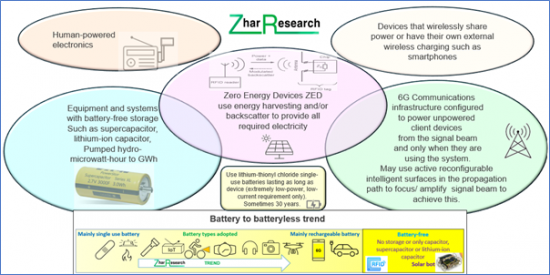
Table of Contents
1. Executive summary and conclusions
- 1.1. Purpose and scope of this report
- 1.2. Methodology of this analysis
- 1.3 20 Primary conclusions
- 1.3.1. 6G and the place of 6G ZED
- 1.3.2. Definition of ZED and 6G ZED timing
- 1.3.3. 6G ZED enabling technologies
- 1.4. Context of ZED: overlapping and adjacent technologies and examples of long-life energy independent devices
- 1.5. Primary 6G infrastructure and client devices becoming zero-energy and battery-free, longer life
- 1.6. Primary enabling technologies for battery-free 6G ZED
- 1.6.1. Device architecture
- 1.6.2. Device battery-free storage: supercapacitors, LIC, "massless energy"
- 1.6.3. Smart materials: metamaterials, self-healing materials, structural electronics
- 1.6.4. System: SWIPT, AmBC, CD-ZED, battery elimination, other
- 1.6.5. 13 families of energy harvesting technology considered for ZED 2025-2045
- 1.7. Eight options that can be combined
- 1.8. Significance of Zero Energy Devices ZED in 6G Communications
- 1.9. Roadmap of 6G ZED and its enabling technologies 2025-2045
- 1.10. Market forecasts 2025-2045
- 1.10.1. High volume ZED devices: 6G ZED IOT and compared to RFID, EAS units billion 2025-2045
- 1.10.2. 6G backscatter SWIPT ZED client devices $ billion compared to RFID, EAS, 2025-2045
- 1.10.3. 6G fully passive metamaterial reflect-array market $ billion 2029-2045
- 1.10.4. Smartphone billion units sold globally 2024-2045 if 6G is successful
- 1.10.5. Market for 6G base stations market value $bn if successful 2025-2045
- 1.10.6. Global metamaterial and metasurface market billion square meters 2025-2045
2. Introduction
- 2.1. Overview
- 2.2. 6G basics
- 2.2.1. Background
- 2.2.2. Why do we need 6G?
- 2.2.3. Disruptive 6G aspects
- 2.2.4. Wireless powered IoE for 6G
- 2.2.5. Arguments against 6G
- 2.2.6. Challenges ahead: cost, runaway electricity consumption and frequency
- 2.2.7. SWOT appraisal of 6G Communications as currently understood
- 2.3. ZED needs and opportunities in 6G Phase 1 and 2
- 2.3.1. Background
- 2.3.2. Specific ZED needs in 6G communications
- 2.3.3. 3GPP and Kristiaanstad University vision of options for 6G ZED and wireless powered IoE for 6G
- 2.3.4. Zero-Energy Device Networks With Wireless-Powered RIS
- 2.3.5. ZED Machine Type Communications MTC
- 2.3.7. Other ZED empowered 6G opportunities
- 2.3.6. Zero-energy air interface for advanced 5G and for 6G
- 2.3.7. Other ZED empowered 6G opportunities
- 2.3.8. First real-time backscatter communication demonstrated for 6G in 2023
- 2.4. Further reading relevant to 6G ZED 2024 and 2023
3. 6G ZED infrastructure and client device enabling technology: metamaterials, IRS, RIS, structural electronics
- 3.1. Metamaterials and metasurfaces enabling 6G ZED by providing zero and low power intelligent surfaces and solar enhancement
- 3.1.1. Overview of metamaterials, IRS and RIS
- 3.1.2. Example: Metamaterial IRS ZED window for 5G then 6G
- 3.1.3. Metamaterial toolkit primary examples, six formats and 6G ZED relevance
- 3.1.4. The meta-atom materials, design and patterning options
- 3.1.5. Commercial, operational, theoretical, structural options evolving for 6G use
- 3.1.6. Metamaterial manufacturing technologies matched to 6G RIS sub-THz, THz and optical versions
- 3.1.7. Metasurfaces for reconfigurable intelligent surfaces and other purposes
- 3.1.8. Primary materials used in 6G IRS and RIS
- 3.1.9. How a 6G RIS is constructed and how it operates
- 3.1.10 8 tuning device families for 6G RIS and their materials requirements
- 3.1.11. Trend from discrete boards, stacked films to full smart material integration, structural electronics
- 3.1.12. Metasurface energy harvesting enhancement useful for 6G ZED
- 3.2. Three SWOT appraisals of metamaterial-based 6G ZED technologies
- 3.2.1. SWOT appraisal for metamaterials and metasurfaces generally
- 3.2.2. SWOT appraisal that must guide future 6G RIS design including ZED versions
- 3.2.3. SWOT appraisal of 6G Communications IRS and RIS opportunities
4. 6G ZED enabling technology: Simultaneous wireless and information transfer SWIPT, Ambient backscatter communications AmBC, crowd-detectable zero energy devices CD-ZED
- 4.1. Overview: backscatter and SWIPT to enable 6G ZED
- 4.2. Hybrid beamforming-based SWIPT
- 4.3. Ambient backscatter communications AmBC and crowd detectable CD-ZED
- 4.3.1. General
- 4.3.2. Orange AmBC and CD-ZED
- 4.3.3. Battery-free AmBC: University of California San Diego
- 4.3.4. Crowd-detectable CD-ZED research
- 4.3.5. Further research from 2024 and 2023-34 selected papers
5. 6G ZED enabling technology: energy harvesting for 6G infrastructure and client devices
- 5.1. Overview: changing needs and 13 technologies
- 5.1.1. Context
- 5.1.2. The increasing electricity consumption of electronics and matching harvesting for ZED
- 5.1.3. Energy harvesting performance comparison: power per unit volume
- 5.1.4 13 families of energy harvesting technology considered for ZED 2025-2045
- 5.2. Harvesting electromagnetic emissions: photovoltaic, ambient RF
- 5.2.1. Photovoltaic: massive power increases ahead from fit-everywhere and efficiency increase
- 5.2.2. Harvesting ambient RF power for devices and communication by recycling existing emissions
- 5.3. Harvesting mechanical emissions: infrasound, acoustic, vibration, other motion using electrodynamic, piezoelectric, triboelectric, other technologies
- 5.3.1. Overview
- 5.3.2. Electrodynamic
- 5.3.3. Piezoelectric
- 5.3.4. Triboelectric
- 5.3.5. Other
- 5.4. Thermoelectric, pyroelectric, hydrovoltaic, biofuel cell and other options
- 5.4.1. Overview
- 5.4.2. Thermoelectric
- 5.4.2. Pyroelectric
- 5.4.3. Thermal hydrovoltaic
- 5.4.4. Biofuel cell
- 5.4.5. Other options
6. Ultra-low power electronics and electrics to make 6G ZED more feasible
- 6.1. Overview
- 6.2. System level energy saving
- 6.2.1. Intermittency tolerant electronics Bfree
- 6.2.2. Ultra-low-power phononic in-sensor computing
- 6.2.3. Improved energy efficiency in 6G Communications: European Commission Hexa-X Project
- 6.2.4. Static context header compression and fragmentation for ZED
- 6.2.5. Wireless sensor networks
- 6.2.6. Ultra-low power radio module and smartphone
- 6.2.7. Other energy efficient sensing, processing and new power transfer options for 6G and IOT
- 6.3. Component-level energy saving: Ultra-low power integrated circuits, low power displays and other
- 6.3.1. Overview: displays and other components
- 6.3.2. Nanopower nPZero
- 6.3.3. Everactive ultra-low power circuits for ZED IOT
- 6.3.4. 2nm chips and beyond-USA, Taiwan, China, Japan
- 6.3.5. Ericsson Research and MIT Lithionic chips
7. Battery elimination, supercapacitors, variants and massless energy for battery-free 6G ZED
- 7.1. Overview
- 7.2. Spectrum of choice-capacitor to supercapacitor to battery
- 7.3. Lithium-ion capacitor features
- 7.4. Actual and potential major applications of supercapacitors and their derivatives 2024-2044
- 7.5. SWOT appraisal of batteryless storage technologies for ZED
- 7.6. Examples of ZED enabled by supercapacitors and variants
- 7.6.1. Bicycle dynamo with supercapacitor or electrolytic capacitor
- 7.6.2. IOT ZED enabled by LIC hybrid supercapacitor
- 7.6.3. Supercapacitors in medical devices
- 7.7. Massless energy-supercapacitor structural electronics
- 7.7.1. Review
- 7.7.2. Imperial College London, Texas A&M University, University of California San Diego, 5 others
- 7.7.3. Structural supercapacitors for electronics and devices: Vanderbilt University USA
- 7.7.4. Transparent structural supercapacitors on optoelectronic devices
- 7.8. Research pipeline: Supercapacitors
- 7.9. Research pipeline: Hybrid approaches
- 7.10. Research pipeline: Pseudocapacitors






